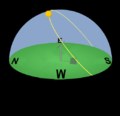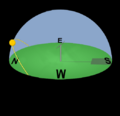Difference between revisions of "Shading"
| Line 1: | Line 1: | ||
[[Category:PV source]] | [[Category:PV source]] | ||
| − | The amount of energy that a PV system produces has a direct relationship to the amount of sunlight that it receives. Shade therefore | + | The amount of energy that a PV system produces has a direct relationship to the amount of sunlight that it receives. Shade therefore has a significant effect upon production. It is ideal for PV modules to be in a location without any shading during the entire day and throughout the year, unfortunately this is often not the case. As the sun rises or falls in the sky, its angle becomes lower and the shadows that are cast become longer, which means that shade is an inevitability in most locations. If a PV module can be kept shade free from 9:00 to 15:00, its production will not be severely affected, but shading during these crucial hours when the sun is at its strongest will cause a significant drop in production. How badly production will be affected will depend upon a few different factors: |
*The intensity of the shade (is it really weak from something in the distance or from something only a few meters away?) | *The intensity of the shade (is it really weak from something in the distance or from something only a few meters away?) | ||
*How much of the module is shaded | *How much of the module is shaded | ||
*What part of the module is shaded | *What part of the module is shaded | ||
| − | + | As the sun changes position in the sky throughout the day and throughout the year, it is important to consider shade during the entire year when designing and installing a PV system. Shading issues become more pronounced at higher latitudes. For more information on the position of the sun through the year, see [[Tilt and orientation]]. | |
| + | |||
| + | <gallery heights=250px> | ||
| + | File:Barilochesummershadow.png|Shadow cast at 12:00 on December 21 in Bariloche, Argentina (41°S). | ||
| + | File:Barilochewintershadow.png|Shadow cast at 12:00 on June 21 in Bariloche, Argentina (41°S). | ||
| + | File:Verticalshade201005.png|60-cell module. Strong shading down an entire column of cells will only trigger one bypass diode. 33% of module production will be lost. | ||
| + | </gallery> | ||
==Bypass diodes and shading== | ==Bypass diodes and shading== | ||
| Line 24: | Line 30: | ||
File:Strongshadeline.png|60-cell module with a line of high intensity shading. | File:Strongshadeline.png|60-cell module with a line of high intensity shading. | ||
</gallery> | </gallery> | ||
| + | |||
| + | ==Evaluating shade== | ||
| + | affect production there is the option of using | ||
| + | shade analysis tools to better understand the effects. The most practical and cost effective tool is called the Solar | ||
| + | Pathfinder. | ||
==Module orientation and shading== | ==Module orientation and shading== | ||
| − | + | If there is strong shading from an obstacle like a mountain to the East (shading in the morning) or West (shading in the afternoon), orienting the panel somewhat in the direction with the better solar resource should be considered in order to maximize production. | |
| − | |||
| − | If there is a shading | ||
| − | |||
Shading frequently happens in the morning or in the afternoon as the sun’s angle is lower in the sky. In some | Shading frequently happens in the morning or in the afternoon as the sun’s angle is lower in the sky. In some | ||
places it is unavoidable, but if the modules are free from shading between 9am and 3pm, production will not be | places it is unavoidable, but if the modules are free from shading between 9am and 3pm, production will not be | ||
very dramatically affected. | very dramatically affected. | ||
| − | |||
| − | |||
| − | |||
| − | |||
| − | |||
| − | |||
| − | |||
| − | |||
| − | |||
| − | |||
Revision as of 14:31, 5 October 2020
The amount of energy that a PV system produces has a direct relationship to the amount of sunlight that it receives. Shade therefore has a significant effect upon production. It is ideal for PV modules to be in a location without any shading during the entire day and throughout the year, unfortunately this is often not the case. As the sun rises or falls in the sky, its angle becomes lower and the shadows that are cast become longer, which means that shade is an inevitability in most locations. If a PV module can be kept shade free from 9:00 to 15:00, its production will not be severely affected, but shading during these crucial hours when the sun is at its strongest will cause a significant drop in production. How badly production will be affected will depend upon a few different factors:
- The intensity of the shade (is it really weak from something in the distance or from something only a few meters away?)
- How much of the module is shaded
- What part of the module is shaded
As the sun changes position in the sky throughout the day and throughout the year, it is important to consider shade during the entire year when designing and installing a PV system. Shading issues become more pronounced at higher latitudes. For more information on the position of the sun through the year, see Tilt and orientation.
Contents
Bypass diodes and shading
The cells of a PV module are connected in series. If one part of a part of a series circuit has high resistance or is not performing properly, it becomes a constraint for all of the other parts of the circuit. PV modules have incorporated bypass diodes in their junction boxes which automatically bypass strings of cells that are not performing properly. The typical PV module only has three different strings of PV cells, connected along the long axis of the module, protected by bypass diodes. This has important consequences for how a PV module performs when there is shade as bypass diodes respond variably depending upon the conditions. Shading along the short-axis (rows) of the module will have a greater impact than shading along the long-axis (columns) of the module
Partial shading and shade intensity
Strong shade and shading that covers an entire PV cell is likely to trigger bypass diodes and will result in a significant loss in PV module production. Weak shading or partial shading on a PV cell may cause overall performance of the module to drop without being strong enough to trigger a bypass diode. A common example may shade resulting from a tree branch is close to the module and provides a thick dark line of shade, it will cause significant problems, but a distant branch causing a faint line of shade will not likely cause much production loss.
Evaluating shade
affect production there is the option of using
shade analysis tools to better understand the effects. The most practical and cost effective tool is called the Solar Pathfinder.
Module orientation and shading
If there is strong shading from an obstacle like a mountain to the East (shading in the morning) or West (shading in the afternoon), orienting the panel somewhat in the direction with the better solar resource should be considered in order to maximize production. Shading frequently happens in the morning or in the afternoon as the sun’s angle is lower in the sky. In some places it is unavoidable, but if the modules are free from shading between 9am and 3pm, production will not be very dramatically affected.






